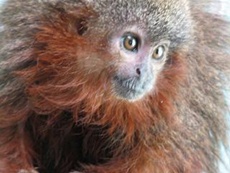Purring monkey among hundreds of new animals found in Amazon rainforest
26 Oct 2013
A monkey which makes a feline purring sound is among the at least 441 new species of animals and plants discovered over a four-year period in the vast Amazon rainforest.
 The "remarkable" Caquetta titi monkey as described by the World Wildlife Fund (WWF), or Callicebus caquentensis, is among the new species discovered between 2010 and 2013.
The "remarkable" Caquetta titi monkey as described by the World Wildlife Fund (WWF), or Callicebus caquentensis, is among the new species discovered between 2010 and 2013.
The monkey was spotted in Colombia by a team which included scientist Thomas Defler, who said the animal had an endearing trait.
He added, when the monkeys felt very content they purred towards each other.
The new creature is among the 20 species of titi monkey, that inhabit the Amazon Basin.
Much of the rainforest - the largest in the world, that covers a third of South America is yet to be fully explored.
The monkey, is the only new mammal species found during the four-year study of the Amazon. Besides, the researchers discovered 258 species of plants, 84 fish species, 58 species of amphibians and 18 species of birds, in addition to numerous insects and invertebrates.
Among the remarkable creatures discovered are a shy lizard with "war paint" markings, a vegetarian piranha that feeds on river weeds and a thimble-sized frog.
''These species form a unique natural heritage that we need to conserve. This means protecting their home – the amazing Amazon rainforest – which is under threat from deforestation and dam development,'' said Claudio Maretti, Leader of Living Amazon Initiative, WWF.
According to Damian Fleming, head of programmes for the Amazon at WWF UK, the richness of the Amazon's forests and freshwater habitats continued to amaze the world.
He said, the more scientists looked, the more they found.
He added, with an average of two new species finds on a weekly basis for the past four years, it was clear that the extraordinary Amazon remained one of the most important centres of global biodiversity.
However, the WWF warned the rainforest remained under threat from tourism and deforestation.
Many of the newly-found wildlife species are found in only small parts of the Amazon.
Fleming said the discovery of these new species reaffirmed the importance of stepping up commitments to conserve and sustainably manage the unique biodiversity and also the goods and services provided by the rainforests to the people and businesses of the region.
Currently, the rain forest is losing out to logging, agriculture and farming at a staggering pace of three-football pitch sized sections every minute.
The red-bearded Caqueta titi which has a known range of only 60 miles is already in the list of critically endangered species.
WWF has undertaken an major effort to preserve the Amazon's biodiversity, under its programme, Sky Rainforest Rescue.
The organisation is helping to save 1 billion trees in the Brazilian state of Acre, by making the trees worth more standing than cut down.













.jpg)






.jpg)









